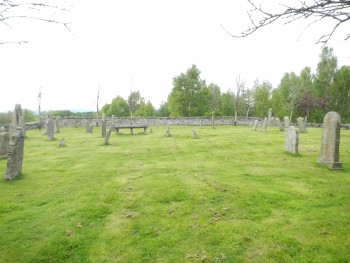- Navigation:
- Back to the Corpus index page
- RSS
Luncarty Parish Church
Luncarty Churchyard, 1
- Dedication: St Fillan?
- Diocese of St Andrews
- Deanery of Gowrie
- NO 094 300
Summary description
Demolished after 1614, there are possible faint traces in the churchyard.
Historical outline
Dedication: St Fillan?
With its possible dedication to St Fillan,(1) almost no references to this church have survived from the Middle Ages. What is likely to be the earliest known reference is the record in 1275 of a church of Lonchorn in the accounts of the papal tax-collector in Scotland, where it occurs as a free parsonage paying a tax of six merks.(2) Luncarty appears to have survived as an independent parish church throughout the pre-Reformation period, being recorded in the 1560s as such when in the hands of Mr Walter Balfour, parson, it was valued at £26 13s 4d with deduction for a curate’s fee.(3)
Notes
1. J M Mackinlay, Ancient Church Dedications in Scotland: Non-scriptural Dedications (Edinburgh, 1914), 168-9.
2. A I Dunlop (ed), ‘Bagimond’s Roll: Statement of the Tenths of the Kingdom of Scotland’, Miscellany of the Scottish History Society, vi (1939), 39.
3. J Kirk (ed), The Books of Assumption of the Thirds of Benefices (Oxford, 1995), 322.
Summary of relevant documentation
Medieval
Synopsis of Cowan’s Parishes: Listed as an independent parsonage in Bagimond’s Roll, the church remained unappropriated at the Reformation.(1)
According to Mackinley the church was dedicated to St Fillan.(2)
[No pre-Reformation references to the church]
Post-medieval
Books of assumption of thirds of benefices and Accounts of the collectors of thirds of benefices: The Parish church was independent, held by Walter Balfour, value £26 13s 4d, including curate fee.(3)
Account of Collectors of Thirds of Benefices (G. Donaldson): Third of parsonage and vicarage £8 17s 9 1/3d.(4)
1642 (17 Aug) Following an act of the General Assembly anent the patronage of churches the Presbytery of Perth records the patrons of churches within its bounds; Perth belongs to the town, Kinnoul belongs to the earl of Kinnoul, Scone belongs to the king, Cambusmichael also belongs to the king, Kilspindie also belongs to the king being a former kirk of abbey of Scone, Errol belongs to the earl of Kinnoul, Kinfauns belongs to the king being a former kirk of the abbey of Scone, Rhynd belongs to the king being a former church of the priory of Pittenweem, Arngask belongs to the king being a former church of Cambuskenneth, Dunbarney belongs to the town of Edinburgh, Forteviot belongs to the (old) college of St Andrews, Methven belongs to the Duke of Lennox and Luncarty belongs to the king.(5)
Notes
1. Cowan, The parishes of medieval Scotland, 141.
2. Mackinley, Non-Scriptural Dedications, p. 168-169.
3. Kirk, The books of assumption of the thirds of benefices, 324.
4. Donaldson, Accounts of the collectors of thirds of benefices, 15.
5. NRS Presbytery of Perth, Minutes, 1618-1647, CH2/299/1, fol. 423.
Statistical Accounts]
Bibliography
NRS Presbytery of Perth, Minutes, 1618-1647, CH2/299/1.
Cowan, I.B., 1967, The parishes of medieval Scotland, (Scottish Record Society), Edinburgh.
Donaldson, G., 1949, Accounts of the collectors of thirds of benefices, (Scottish History Society), Edinburgh.
Kirk, J., 1995, The books of assumption of the thirds of benefices, (British Academy) Oxford.
Mackinley, J.M, 1914, Ancient Church Dedications in Scotland. Non-Scriptural Dedications, Edinburgh.
Architectural description
The church at Luncarty remained unappropriated throughout the middle ages.(1) The parish was united with Redgorton in about 1614,(2) and the church was subsequently abandoned and demolished. It presumably stood within a walled churchyard to the north west of the village that has been in use for burials since at least the eighteenth century on the evidence of the memorials within it.
Nothing remains above ground of the church, but near the middle of the churchyard are faint traces of what appear to be parallel lines on an east-west alignment. It appears possible that these mark the site of the church.
Notes
1. Ian B. Cowan, the Parishes of Medieval Scotland (Scottish Record Society), 1967, p. 141.
2. Royal Commission on the Ancient and Historical Monuments of Scotland, CANMORE on-line resource.
Map
Images
Click on any thumbnail to open the image gallery and slideshow.






